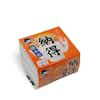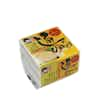




Natto (Dried Fermented Soybeans) from Japan
A uniquely Japanese experience
TASTING NOTES FROM THE CURATOR
A traditional Japanese food, natto is, simply put, whole fermented soybeans. They are first steam cooked, then fermented with Bacillus subtilis, a healthy bacterium. It’s an acquired taste for most people, as its aroma and its sticky appearance can be a little daunting.
It has a pungent smell, similar to smelly cheese. The beans are light to dark brown in color, and as a whole, take on a slimy texture, with long stretchy strings of stickiness. When eaten, the beans are semi-firm with a soft center. Its flavor is reminiscent of aged cheese—mildly fermented to taste, with slightly bitter, earthy notes.
There are 3 variants to choose from at The Bow Tie Duck:
- NATTOKU GOKU-KOTSUBU - composed of mini soybeans
- TSUU NO CHUTSUBU - composed of medium-sized soybeans
- TSUU NO HIKIWARI - made with crushed/ground soybeans
PREPARATION AND PAIRINGS
Natto is often eaten for breakfast or lunch, with hot rice or udon noodles, and some sides of vegetables, green onions and condiments like soy sauce or karashi mustard. But natto can also be the accompaniment, paired with dishes like tempura, okonomiyaki, or Japanese curry.
A UNIQUE DISCOVERY
Natto has been part of Japanese cuisine for centuries. There are two legends tied to its origins. One of them involves Minamoto no Yoshije, a samurai who was in northeastern Japan on a campaign in around 1086AD. His troops were attacked while they were boiling soybeans for their horses, and in a hurry, packed up the beans in straw bags. They did not open these bags until days later, discovering that the beans had fermented. They ate it anyway, and offered some to the samurai, and they discovered that they liked it.
A second story tells of Prince Shotoku, who wrapped the leftovers of boiled soybeans in straw bags to give to his horse. For some reason, the fermented soybeans found their way to human mouths, and they found them delicious, quickly gaining popularity in Japan for its unique taste.
Storage Instructions
You may store your natto in the refrigerator. Keep in an airtight container, with a piece of cheesecloth or unbleached parchment paper over it to absorb moisture. The longer it’s stored, the more intense the flavor gets. Consume within 6 weeks.











